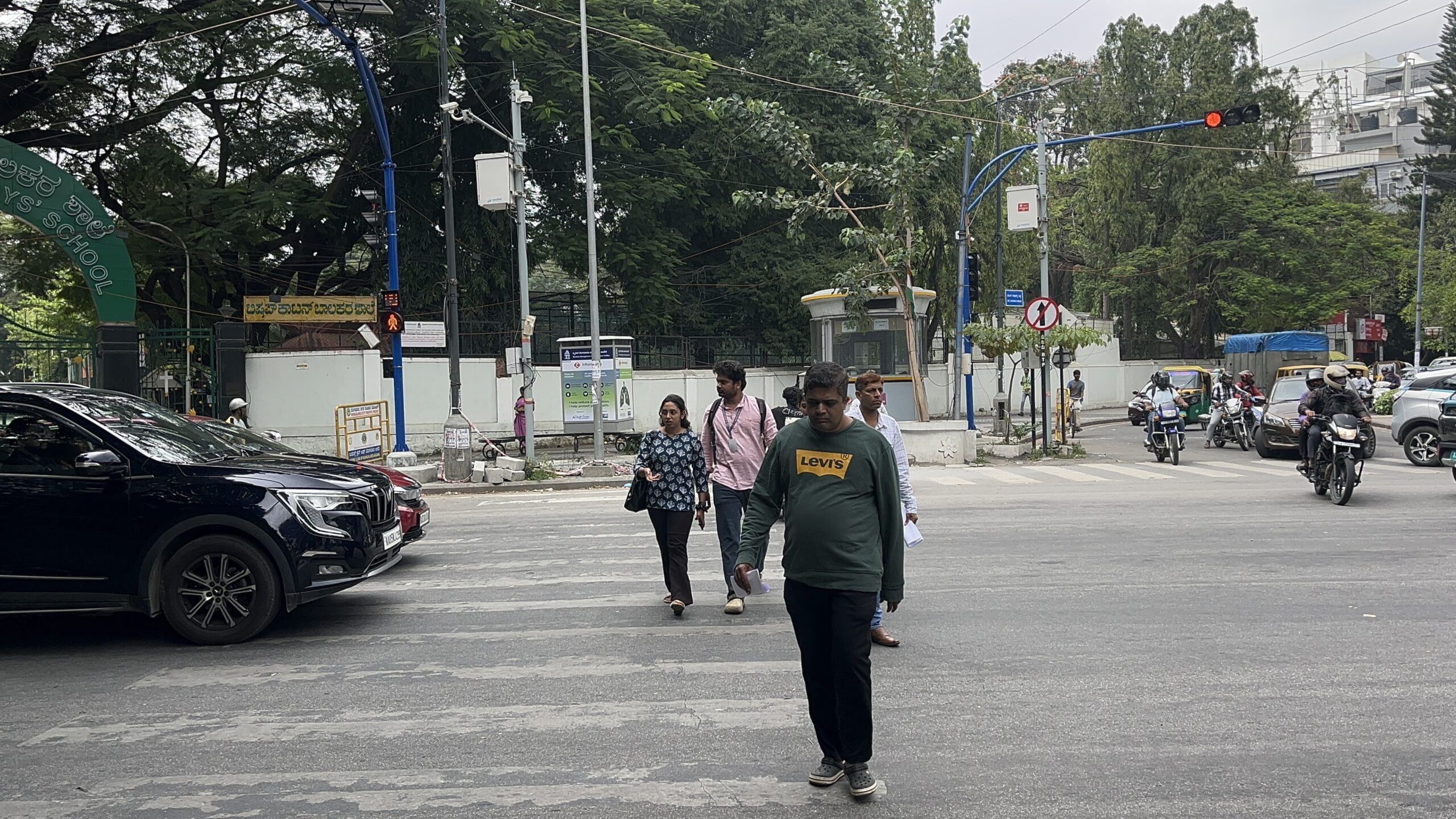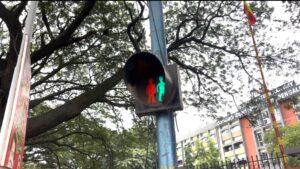The Bengaluru police have implemented the Adaptive Traffic Control System to ensure a smooth flow of vehicular traffic. However, the system seems to have turned a blind eye towards pedestrians.
Published Nov 10, 2024 | 10:38 AM ⚊ Updated Nov 12, 2024 | 6:58 PM

Motorists have scant regard for pedestrians as they stop their vehicles on zebra crossings.
Pedestrian signal lights in Bengaluru present a curious case. While some walk lights blink for merely a second, a few others give a window of five seconds for pedestrians to cross the crowded roads.
Further investigation revealed that since a majority of Bengalureans use public or private vehicles, the focus has primarily been on smooth vehicular traffic flow.
Recently, the Bengaluru police implemented the Adaptive Traffic Control System (BATCS) to reduce travel time and improve traffic flow at key junctions across the city. Sources told South First that the AI-powered system is part of a broader plan to modernise traffic management in Bengaluru.
But, what about pedestrians? In the rush to make it easier for vehicle users, pedestrians have got the short end of the stick.
According to the Indian Road Congress (IRC) recommendations, pedestrian signal time should be 15-20 seconds, depending on the road’s width.
Traffic and mobility expert MN Sreehari, who is also an advisor to several governments and smart cities for transportation summed up the present situation: “I have wondered many times what will happen to pedestrians. Even before the signal turns from red to green, both people and vehicles begin to move. Nobody has the patience to wait.
South First visited several traffic signals in Bengaluru’s bustling Central Business District (CBD) to understand how pedestrians struggle to cross roads.
There are two major signals at the Cauvery Emporium that lead to the famous Brigade Road. Vehicles converge at the signal from Anil Kumble Circle and Trinity Circle.
The pedestrian crossing is at the beginning of Brigade Road and whenever the signal turns green, pedestrians find it difficult to cross due to vehicles still moving past.
The time given for the pedestrian signal over here is 20 seconds but due to vehicles still zooming past, the time is literally cut short to around 10-12 seconds. A good 20-minute’ wait revealed that the situation is normal. Even though there is a traffic police kiosk at the spot, nothing is done to help the pedestrians.
“There should be a little more time. The elderly take time to cross. Vehicles must slow down when the elderly cross the road. The government can give a little more time, especially for the elderly and physically challenged to cross the road,” Maya, a pedestrian opined.
A popular junction in the city, there is constant traffic throughout the day. The pedestrian signal is right near the War Memorial. Pedestrians get 20 seconds to cross the road. Here, it is a bit regulated and pedestrians do not struggle to cross.
Anand who was waiting to cross the road spoke about the insufficient time given, especially for those who are not able-bodied.
“It is difficult to say whether it is sufficient or not as It depends upon the people. It may be a problem for old people but for the middle-aged and young, it may be alright. Generally, we have to be careful while crossing the road. Traffic in Bengaluru has multiplied in the last 20 years, and the volume is much more than the roads can take,” he said.
Vehicles moving from Brigade Road towards Castle Street Junction to join Mission Road that leads to Residency Road take a U-turn at this signal. It is here that the traffic police have installed a pedestrian signal for both roads.
The time given to cross both roads is just 10 seconds and during peak hours, a pedestrian hardly gets 4-5 seconds to cross due to the continuous traffic that seldom halts at the stop signal.
People were seen scurrying across the road after the vehicles moved past and just about making it safely to the footpath before the traffic signal turned green.
During peak mid-morning hours, there is heavy traffic at Shoolay Circle with vehicular movement from Hosur Road, Brigade Road, and General KS Thimayya Road. But what is shocking is that the pedestrians have only 1 second to cross the road!
“It is very difficult to cross here. The pedestrian signal turns green for just 1 second and it is red again. So, we have no other option but to cross the road even if the signal is green or else we will be stuck,” an elderly man said.
South First also noticed many people especially the aged somehow managing to cross the road even as the vehicles kept moving. They have no option whatsoever.
During noon hours when traffic is still chock-a-block, the pedestrian signal time is 10 seconds to cross the road. People who are regulars here tell us that it is not sufficient especially because of the large numbers of people who walk in this area.
With many schools and colleges nearby, there is a demand though for the signal duration to be increased to 20 seconds so that hundreds of school students can cross with ease instead of waiting for 100 plus seconds to cross the road.
A few college students who are pursuing their fourth-year law graduate degree course were on the road. “I don’t think the time is sufficient. Even when there is a green signal for pedestrians, vehicles continue to move and we do not get the opportunity to cross the road. The time should be increased to help us pedestrians,” one of them, Amogha, said.
There is Good Shepherd’s school, St. Joseph’s school, and college along with people heading towards Brigade Road passing by this small junction. But the traffic police have provided just 5 seconds for pedestrians to cross the road!
Students were seen running across the roads every time the pedestrian signal turned green because the time was just not enough for all of them to cross. We caught up with Vishwas who was one such student who struggled to cross the road.
“I can at least cross the road but what about those who are not able-bodied? How can they cross? The elderly also sometimes run but others have to keep on waiting till there is less traffic,” he said.
The constable at the traffic police kiosk was scratching his head after looking at the signal.

A confusing pedastrian traffic signal.
In the evening, when people were trying to cross the road in front of the Railway Divisional office, the signal would show red and green simultaneously for 10 seconds and then red. But there would be non-stop traffic and people were confused about how and when to cross.
No one seemed to know when the cross. They just dashed across the road when the traffic thinned. The traffic constable present was at a loss for words to explain what was happening.
There are multiple signals present at this circle and while it is fairly well regulated for the movement of traffic — except for the safety of pedestrians.
Peak traffic hours in the evenings are a mess for pedestrians. With just 10 seconds to cross the road, people hardly get at times just 3-4 seconds due to the non-stop traffic that just does not stop.
Crossing the road here is a nightmare for the aged, injured, or cannot walk fast due to multiple reasons.
With metro stations surrounding this junction, hundreds of people step out to cross the roads but struggle to cross with absolutely no help from the traffic police present.
Explaining the new concept or thought being put into practice, Sreehari said the roads are meant for traffic flow while the footpath is for pedestrians. They want pedestrians to quickly cross the road so that they make way for vehicles to move. But he questioned the practice: What will happen to children, women, and the elderly who also need to be thought about?
When informed that pedestrian signal time duration is as low as 1 second and 5 seconds, he said, “Earlier, police used to contact experts to work out how much time is needed for pedestrians to cross the road… Police today used simulations. Crime police are transferred to traffic due to transfers, so what can you expect from them? They cannot do any justice here,” he opined.
He claimed that there are experts who know about this situation and help solve the issues. They will visit the junctions, study the trend, average time is taken, width of the road, amber time, and much more.
Nobody should run across the roads; they need to walk across safely while crossing the roads. “The police way of thinking things will be different. They think a thief will run so the police should run to catch them. That is the concept they follow. This should not come while dealing with traffic. Here, safety is an important criterion,” he added.
(Edited by Majnu Babu).
